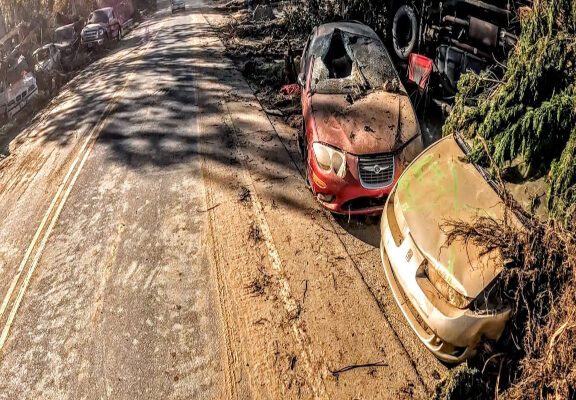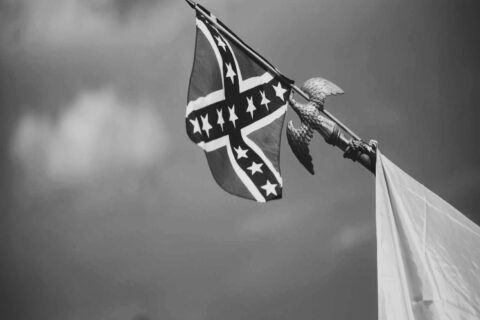How many things are blood and soil? Soil doesn’t mean your people or a specific territory. It’s the cultivation of that land, spiritual and the physical connection you have with that area. It’s what makes us who we are. When you are removed from that land, you lose a part of yourself.
I moved to Asheville during the COVID-19 scamdemic to escape the ongoing calamity of New York City, knowing the city’s trajectory was downwards and all I worked and lived for was being eviscerated at breathtaking speeds. My mother, a schoolteacher living off a modest pension, cashed in the family house, and my brother, a typical 13th grader(NEET) who would only be left homeless if he had stayed already left some few years prior, waxed poetic of the Appalachian beauty. I enjoyed the “Keep Asheville Weird” spirit when I arrived despite the city’s ethos. Though unshaven and covered in tattoos, the women are more straightforward, easier to befriend, and not career-oriented. Men are more honest and do not look for a monetary benefit from you. There is an uplifting spirit yet immature that carries you. Here, you can forget hyper-modern drudgery and live and let live. The culture affirms that anyone can become anything—even, at its most exuberant, that everyone can become everything. It’s all personal choice, with life pared down to an extreme utopian individualism. Drinking IPA beers brewed locally, smoking a doob while sitting in a tube floating down the French Broad River, and tuning out was something I hadn’t done in years, nor could I do in New York. But Western North Carolina was changing, and the change was not measured in years but in months.
To start, Asheville and its periphery, like most cities, along with the Appalachian Trail, was sparsely populated, with only 1000-2000 inhabitants by the end of the Civil War. There were light skirmishes during the Civil War, with many local historians boiling the battles down to drunken bar fights. Fast forward to the Depression era, the city defaulted on Depression-era bonds. The city decided to pay it all back, and the slate was not cleared till 1977, leaving Buncombe County desolate until the 90s. The only economic driver keeping the city alive was Northwestern Bank, with its 228-foot-tall building now a condominium hotel hybrid at the heart of the downtown and sitting fittingly across the street from the now-removed Zebulon Baird Vance monument during the summer of Saint Floyd. As the ’00s rolled around with college enrollment meeting national peaks, many graduates nearby decided to move into the area. In 2004, Highland Brewery was founded, leading to a further 17 breweries, making it the city with the most breweries per capita in the region. 12 national parks nearby along with the largest home in the United States, the historic Biltmore Estate which comprises of a chateau sitting on 100,000 acres of land, makes it one of the region’s the most popular tourist destinations.
An artificial culture emerged, a more debauched version of the 60s counterculture and morphing post-Covid of an unscrupulous bourgeoisie. An ecumenism of mindless positivity. Refrigerator art artists and fast-food spirituality types. Generally speaking, its habitants are trust fund hippies, smug liberal boomers, drug addicts, nomads, politically fringed non-aggression principle types, those from poor blue-collar broken homes, and, of course, lots and lots of lesbians. Hence why, if you look at the political landscape of Appalachia, Asheville seems out of place, leading to disharmony amongst the majority who have been displaced by transplants. It should be noted that Billy Graham Training Center is in East Asheville, and Billy passed away in Buncombe County. Asheville is the optimity of an island with short-term social and economic goals. A place that heavily depends on the native population, where a handshake is good enough to make sure the job gets done, and Hispanic laborers who fair well because the transplants are too old, too strung out, or are just too lazy to provide what are actually needed to make a community run. While I lived there, the scene of the Du Lung bridge from Apocalypse Now is something that passed through my mind often, and I equated the city to it. No leadership, no forward guidance, a place where its denizens are naïve and purblind to the vertiginous chaos of social decline. Nothing more than a place of happenstance for people to spin their wheels and only find futility in life in hyper-modern America. What they have in common with each other is a make-believe aspic of fear of bible thumpers (the ones who provide electricity to them) and enforcing some form of Christian Shira.
You will meet Ashevillians holding contradictory views of “down with fascism” yet quick to embrace fascist government tendencies like mask mandates and 3rd round boosters. Gratitude Meditation is safe, yet prayer is frowned upon and viewed as superstitious. Civil Engagement can be boiled down to free-ranged homeschooling and bringing your baby (or furbaby) to the brewery on Saturdays. The term moneytheism comes to mind when discussing these distinct sects and their subgroups, an ideology coined by the former foreign minister of Singapore, S. Rajaratnam, where he noticed a vague, nondescript, unalloyed group of ex-pats and newly minted immigrants who undermined Singapore, local distinctiveness, civility and patriotism with unmoored morals and values. This archetype takes a tourist-like approach to morality. I use the word tourist as a pejorative since they do not view where they reside as home, and how Asheville is almost solely dependent on tourism to keep its economy from looking like the rest of the Appalachian Trail. They are from somewhere but reject where they are from wholeheartedly and embrace this new identity. Conversing and inquiring where they are from, they quip and say something like, “I’m from Swananowhere.” This is in reference to the Swannanoa River that runs through Asheville and the adjacent town. You make friends one day, and they relocate tomorrow. A jarring experience for anyone trying to create long-lasting relationships. This leads to many only knowing others superficially or not making acquaintances at all (Disc Golfing Alone). The native population tends to keep its distance from the transplants for a litany of reasons.
Asheville today lives off its reputation from a quarter of a century ago. Transplants were expecting something edgy, an outlier in a hyper-modern society, as a means to get away from private equity and development. A concept similar to those on the right side of politics looking for a “trad life” minus the hard work part. When the lockdowns happened, it was an excellent excuse for people from all walks of life to leave urban centers and find a middle ground. That middle ground is a place such as Asheville. Young disenfranchised people fled, thinking it would be a place to find meaning, yet their parents and neighbors felt the same way. Capital investment looking to flow out from the overtaxed, overregulated northeast flooded the region where local politicians could not resist, and knowing civil engagement being nonconstructive gave way to technocrats to set policy.
The rise of “bring your own work” remote gigs, senescent retirees, and the explosion of some 3,000 homes purchased for Airbnb put pressure on infrastructure that could not keep up with demand, with an average home price selling for $320,000 in 2019 to $573,000 at the tail end of 2024. Sadly, those under 35, who make up almost 40% of Buncombe County’s population, are regulated to jobs in the service industry and serve people who aren’t contributing meaningfully to the local economy. They assume their civic coolness (being woke) or being obsequious to whatever the latest global mantra will somehow either keep them afloat or push them up in the income bracket. There are more takers than givers, with transplants expecting and demanding urban amenities the area does not have, leaving the area to resemble something you would find at a seasonal resort in Greece. Asheville is ranked dead last in the nation for the lowest standard of living for college graduates. The economy lacks dynamicism and scale, coupled with the hollowing out of American manufacturing and being a right-to-work state, you could make the same money busing tables as a paramedic ferrying fentanyl addicts from a hospital to a shelter. It is either you own a business, or you work for under $20 an hour.
When Helene hit, I knew the ramifications would be the equivalent of a social atomic bomb going off. Social media exploded with people from out of state asking the whereabouts of loved ones. It displayed to me how disconnected we are when those who apparently care about you, grandstanding and empty virtue signaling on social media, are twelve hours away by car and have no intention of actually going to them to make sure they are well. Helene is a reminder, just as in Hurricane Katrina, of what happens when disaster strikes a complex society. The bottom fell out; many who relocated during COVID-19 have second-guessed their choice of relocating, some arriving only weeks before the disaster being airlifted off the top of a mountain. Native Appalachians fending for themselves, relying solely on their local church, with little to no federal money being handed out to them. FEMA temp workers arrived on the scene; many were black and from adjacent states, holding some grudge towards native whites, and looked at the liberal bleeding hearts with indifference. FEMA has always sought any excuse not to shell out any type of assistance to areas that have no value to global markets. The crescendo of the feeble federal government came to a head when Homeland Security Secretary Alejandro Mayorkas stated FEMA does not have enough money for hurricane victims due to a 9 billion dollar shortfall.
Shortly after his statement, FEMA launched a “Fact Checker” page on its website and doled out a measly $750 one-time payment to hurricane victims. What is more telling is on September 26th, amid Helene, Congress declined to fund FEMA’s Disaster Relief Fund, breaking with past practice. Congress left FEMA to draw on its overall budget for the new fiscal year to fund the DRF. In my opinion, the biggest blackpill came from Senator Lindsey Graham when he was on Fox News with Sean Hannity, shifted a conversation away from the natural disaster and focused on the need to send more weapons to Ukraine and Israel by saying:
But look what’s [sic] going on in Israel. Our friends in Israel are surrounded by people that want to kill them, destroy them, a second holocaust in the making. . . . They’re running out of ammunition in Israel. We have to help our friends to keep the war over there from coming here. . . . They have been slow-walking weapons in Ukraine. Ukrainians have been doing all the fighting.
HOA communities built in an unsustainable fashion along riverbanks owned by halfback boomers fled to where they hail from and sit abandoned, awaiting insurance payout. The younger demographic is in a state of shock, hot bunking with friends or coworkers, piecing what little they have together, and are stuck roughing the winter when there are no tourists. Many, including my mother, have gone 9-plus weeks without running water, unsure of who or where to turn to. Signs erected on many streets warning looters they will be shot on site. Who are not being talked about are the no-named drifters, the homeless, and drug addicts who pitch makeshift encampments up on the nearby peaks to hide. The encampments remain, but they are gone. Rumors running wild of hundreds of them being unaccounted for, most likely buried under river silt, never to be found. Less than a week after the storm passed, anyone with a half-decent recording device and an insta-following showed up, taking photos and videos of the devastation. Devastation/fear porn seems to be the new norm for vloggers, as it tends to garnish the most eyeballs. The vloggers are glib when talking to those whose homes are now miles downriver. A dissociation is associated with vloggers; somehow, it is fashionable to be unempathetic and disingenuous.
The question is how Ashville will rebound in the short term, and what would happen to cities inflicted with post-familial gentrification. Will they be able to cope with a catastrophic event that would make Helene look like a spring shower? One must realize Asheville suffers from a sentimentalization of discourse. Ashvillians have been spoon-fed platitudes their entire lives and never had challenges in any meaningful way. Powers of deductive reasoning are neutered. Illusions keep people in a state of infantilism, hence why many who live there are atomized by hyper-modern living, expecting that “someone” or the “system” will save them. So long as the papered-over economy stays the course and upright, morally balanced people continue to tolerate others who tolerate actions they deem reprehensible, then Asheville will theoretically strive. However, it would be technically considered a “failed state” because of its unscrupulous culture. Families who can trace their roots to the Civil War and are stuck one way or another in the area will fare better during a long-lasting collapse. But if the prevailing culture soldiers on, the Appalachian Hillbilly will be soon extinct with the ongoing opioid crisis, lack of education and no political representation, which I don’t think will come to them anytime soon.
The desire for social connectivity is one of the most fundamental and universal of all human needs and it is something we have all forgotten.
-By Lamprey Milt

Visit The American Sun at The American Sun






An eve opening read thanks.
To those roughing it out this winter in Dixie!
It will only make you stronger!
God Bless Dixie
Good article